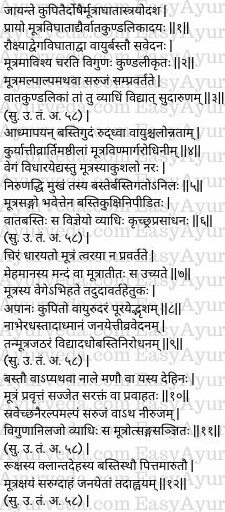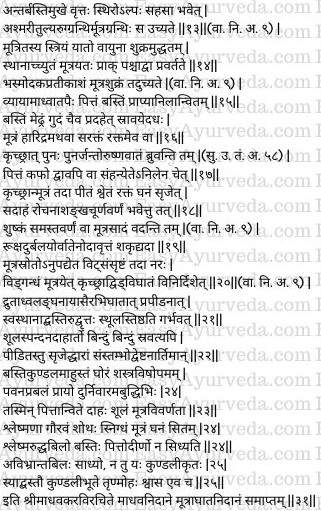Madhava Nidana Chapter 31 Mutraghata Nidana
This article explains Madava nidana 31st chapter “Mutraghata Nidanam”. Causes, pathology and symptoms of Mutraghata are explained in this chapter. Mutraghata is a group of disorders associated with urinary obstruction.
Read – Acharya Madhavakara: His Work ‘Madhava Nidana’, Legacy, Amazing Facts

Table of Contents
Mutraghata Nidana, Samkhya
Etiological factors and number of mutraghata
Causes – Suppression of natural urge for urination and other urges (like that of defecation, ejaculation etc.) and consumption of dry foods (and other etiological factors which cause predominant vitiation of vata) are the chief causes of mutraghata – suppression of urine.
Pathogenesis and number of mutraghata – The doshas (one or more of the doshas), predominantly vata, aggravated by the above mentioned etiological factors cause thirteen types of mutraghata commencing with Vatakundalika. (1)
Read – Urinary Obstruction: Causes, Types, Symptoms, Ayurvedic Treatment

Vatakundalika
Excessive indulgence in dry foods, suppression of natural urges of the body etc. are the etiological factors of Vatakundalika. These causes lead to aggravation of vata located in the urinary bladder. This vata moves all around in a circular way obstructing the urine and also causes pain in the urinary bladder.
There is either scanty urination (frequent passage of small quantities of urine) or painful urination. This dreadful condition is known as Vatakundalika. (2-3)
Asthila
The vata which has abnormally increased in the urinary bladder causes distension of the urinary bladder and rectum and would cause an enlargement (cyst like structure) which resembles an asthila (round pebble or stone ball) and hence the name asthila. This is elevated and mobile. It will produce severe pain and obstruction in the passages of urine and faeces. (4)
Read – Effects Of Constant Holding Urine: Ayurvedic Treatment
Vatavasti / Vatabasti
Vatavasti or Vatabasti is a condition caused in unwise persons who suppress their urge for urination and make the habit of the same (suppress urge for urination of long durations and long time). In these people the vata located in the urinary bladder gets aggravated and blocks the opening of the urinary bladder (urinary passages) and abdomen. This causes total retention of urine and also pain in the region of the urinary bladder. This disease is known as Vatavasti and is difficult to cure. (5-6)
Mutratita
When a person is habituated to suppress the urge of urination for a long time (and also has suppressed it for a long time) he fails to void the urine with normal force (and speed). Even if he voids the urine, it will be in a very slow stream. This condition is called as Mootraatita. (7)
Mutrajathara
Suppression of the urge of urination is the cause for udavarta (reverse / upward movement of vata). Apaanavata getting increased begins to move upwards and accumulates in the abdomen, causing distension of the abdomen below the umbilicus, along with severe pain and obstruction in the lower part (opening) of the urinary bladder. This condition is known as Mootrajathara. (8-9)
Mutrotsanga
Mutrotsanga is a disease in which the urine which has left its seat (to get voided) gets obstructed in the urinary bladder, urethra or glans penis. If the person forcibly tries to void the urine in this condition (strains), the urine flows out mixed with blood or gets voided slowly and in small quantities, with or without pain. This condition is caused by aggravated vata. (10-11)
Read – Mutravaha Srotas Description, Vitiation Symptoms, Treatment
Mutraksaya
In a person whose body is excessively dry and has fatigue, pitta and vata would undergo aggravation in the urinary bladder. They would cause reduction in the quantity of urine (mutraksaya) associated with pain and burning sensation. This condition is called as mutraksaya. (12)

Mutra Granthi
A round, small and stationary cyst like mass developing quickly inside the urinary bladder, which resembles a stone and also presents pain (and other symptoms) similar to those of urinary calculi is called as Mutragranthi. (13)
Read – Benign Prostatic Hyperplasia (BPH) In Ayurveda – Symptoms, Treatment
Mutrasukra
In a person who indulges in sexual intercourse suppressing the urge of urination, vata gets aggravated. By this, the semen which is dislodged from its seat gets obstructed and flows out of the body either before or after the urination. This disease in which the void urine resembles a solution of ash is called as Mutraksaya. (14)
Ushnavata
When a person is indulged in excessive physical exercises, long distance walking and exposure to the heat of the sun, the pitta gets aggravated and reaches the urinary bladder. Here it gets associated with vata and causes burning sensation in the urinary bladder, penis (urethra) and rectum (anus). The urine voided is deep yellow in colour (resembling the colour of turmeric) or mixed with blood or only the blood flows out. The urine frequently comes out in small quantities. This disease is known as Usnavata. (15-16)
Read – Mutra virechaneeya Gana – Urine Detoxifying Group Of Herbs
Mutrasadam
Pitta and kapha either alone or in combination will get condensed (solidified) by the aggravated vata. When this happens there is difficulty in urination. The urine is yellow, white or red in colour, is dense, associated with burning sensation, resembles the colour of the colour of ox bile or conch shell, is dry (the watery portion of the urine is less, non-viscid) and has different colours of all the doshas (due to the aggravation of tridoshas). This condition is called as Mutrasada. (17-18)
Read – Qualities Of Vata, Pitta and Kapha Dosha – Easy Explanation
Vidvighata
In a person who has excessive dryness in the body and is also physically weak, the faeces are pushed in its opposite direction (upward direction) by the aggravated vata. The faeces enter the urinary bladder (urinary passages) and cause difficulty in urination. The urine which is void is either mixed with faeces or obtains the smell of faeces. This condition is called as Vidvighata. (19-20)
Vastikundala
By indulgence in fast walking, jumping and other exercises causing fatigue, injury (by blunt weapons) etc. or due to the pressure (on the urinary bladder, the urinary bladder gets displaced upwards (due to the increased vata) towards the centre of the abdomen and also becomes upside down resembling a pregnant uterus.
In this condition there is pain in the urinary bladder, fluctuations in the region of bladder and burning sensation and the urine is voided with difficulty, drop by drop. The urine flows out in the stream when pressure is applied on the abdomen (the region of the urinary bladder is pressed with hands) but stops when the pressure is released. There is rigidity and cramps. Such a disease is called Vastikundala. It is very dreadful, just like a sharp weapon or poison or a sharp weapon (like an arrow) dipped in poison. Vata is predominantly aggravated in this condition, and should not be treated by a physician with less knowledge.
Read – Urine In Ayurveda – Functions, Importance, Pathology, Treatment
If pitta gets associated (involved) in Vastikundala it causes burning sensation, pain, and discolouration of urine.
If kapha is involved in Bastikundala it causes heaviness and swelling. The urine is oily, thick and white.
If the orifice of the urinary bladder is blocked by thick kapha or if the urinary bladder (inside) gets afflicted by pitta (inflamed or ulcerated) the disease becomes incurable.
On the other hand, if the orifice of the bladder is not obstructed or if the bladder doesn’t get rolled up into a ball like structure Vastikundala becomes curable.
If the urinary bladder becomes rolled up like a ball, it causes thirst, loss of consciousness (delusion) and dyspnoea. (21-26)
Thus ends the chapter on Mutraghata Nidanam in Madhava Nidana text written by Acharya Madhavakara.











